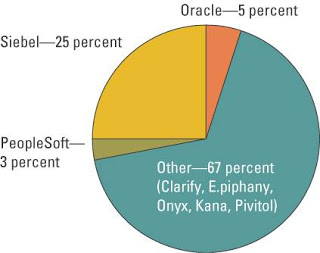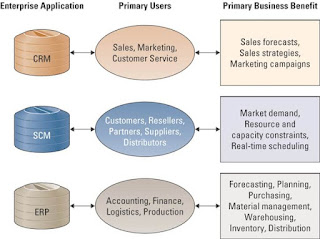Enterprise Resource Planning (ERP)
ü
- At the heart of all ERP systems is a
database, when a user enters or updates information in one module, it is
immediately and automatically updated throughout the entire system
ü
ü - ERP systems automate business
processes
ERP – bringing the organization
together
|
|
|
- Organization before ERP
|
|
|
|
- ERP bring Organization together
|
ü
The Evolution of ERP
Integrating SCM, CRM, and ERP
ü
SCM, CRM, and ERP are the backbone
of e-business
ü
Integration of these applications is
the key to success for many companies
ü
Integration allows the unlocking of
information to make it available to any user, anywhere, anytime
ü
-SCM and CRM market overviews

General audience and purpose of SCM, CRM and
ERP

Integration Tools
ü
Many companies purchase modules from an ERP
vendor, an SCM vendor, and a CRM vendor and must integrate the different
modules together
ü
Middleware –
several different types of software which sit in the middle of and provide
connectivity between two or more software applications
ü
Enterprise
application integration (EAI) middleware – packages together commonly
used functionality which reduced the time necessary to develop solutions that
integrate applications from multiple vendors
ü
Data points where SCM, CRM, and ERP integrate
Enterprise Resource Planning (ERP)
ü
ERP systems must integrate various
organization processes and be:
·
Flexible
·
Modular and open
·
Comprehensive
·
Beyond the company
ü
Flexible – must be able to quickly respond
to the changing needs of the organization
ü
Modular and open – must have an
open system architecture, meaning that any module can be interface, with or
detached whenever required without affecting the other modules.
ü
Comprehensive – must be able to support a
variety of organizational functions for a wide range of businesses
ü
Beyond the company – must support external
partnerships and collaboration efforts
ü
Enterprise Resource Planning’s Explosive Growth
ü
SAP boasts 20,000 installations and 10 million
users worldwide
·
ERP solutions are growing because:
·
ERP is a logical solution to the mess of
incompatible applications that had sprung up in most businesses
·
ERP addresses the need for global information
sharing and reporting
·
ERP is used to avoid the pain and expense of
fixing legacy systems






No comments:
Post a Comment